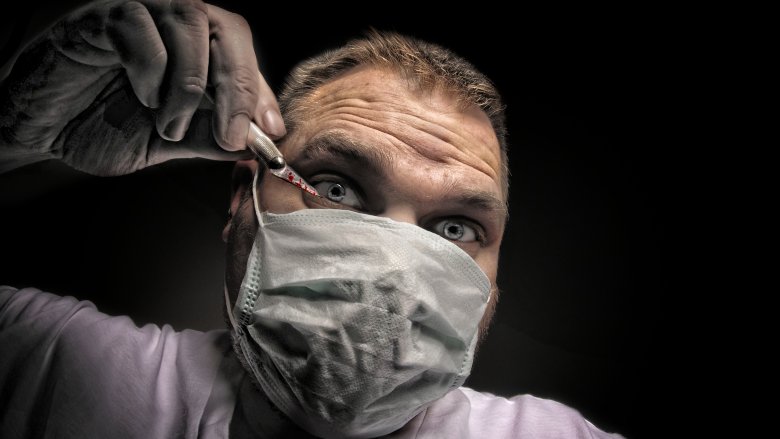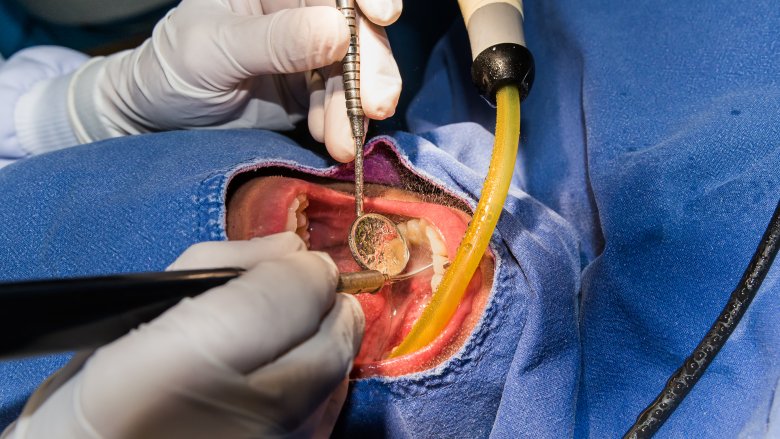The Most Bizarre Medical Horror Stories
Life is rife with vicious vicissitudes that can annihilate your health at any moment. Perhaps an arthritic archer with an eye itch and bad aim will grievously puncture your pancreas. Maybe you'll contract chlamydia or stub your love stump. Thankfully, medical professionals can assail whatever ails you with a barrage of unpronounceable drugs and magnificent machines. It might take a few needles or a few million dollars, but doctors and nurses help stave off hearses.
Unfortunately, the road to recovery has potholes. Healing can be halted by infections or anaphylactic reactions to treatment. Physicians occasionally encounter anomalous maladies. Sometimes surgery moonlights as medical torture. These various misfortunes teach the same sour lesson: No matter how bad things get, life can find ways to make them way worse.
A woman misdiagnosed with cancer undergoes unneeded chemo
Cancer is a zodiac killer. Star-crossed souls who are stricken with the illness often have harrowing horror-scopes. Healthy humans sometimes become withered husks, and husky humans might morph into skeletons. Those who are too far gone end up goners. Lamentably, efforts to stem metastasis can add to a sufferer's anguish. Radiation ravages the body, and chemotherapy has horrendous side effects, like lung damage, nerve dysfunction, heart trouble, and hearing loss.
Given such sky-high stakes, doctors generally do their darnedest to prevent cancer misdiagnoses. However, that didn't hold true for one Dr. Ahmad Qadri. According to The Victoria Advocate, in 2009, Qadri diagnosed 54-year old Herlinda Garcia with Stage IV breast cancer after a benign tumor was excised from her left breast. Devastated, Garcia "wrote a bucket list, gave away her keepsakes and planned her funeral." In a bid to prolong her life, she endured eight rounds of chemo. Her husband and four sons watched with helpless horror, expecting Garcia to die.
After seeing a second physician, Garcia discovered she was cancer free. No, it hadn't gone into remission; her physician had been remiss. Dr. Qadri misread Garcia's tests and failed to order a biopsy, plunging her life into disorder. She spent two years awaiting her demise and getting pumped full of noxious drugs. Relieved and revolted, she sued Dr. Qadri. The physician died before court proceedings concluded, but a Texas jury awarded the aggrieved Garcia $367,000. Sadly, no amount of money can buy lost time.
A root canal ruins a man's memory
Dentists improve your smile by making you frown. Their unsettling assortment of shrill drills and gum stabbers seem suitable for both cleaning and killing. But when your teeth have a plaque attack or host a cavity carnival, those dreaded docs are your best line of defense against oral decay. And if the dentist sufficiently drugs you, you might forget all the oral mangling that went into repairing your not-so-pearly whites. That certainly worked for one British serviceman in 2005. In fact, it worked too well.
Per the BBC, the serviceman –- referred to as William -– entered a dentist's office on March 14 to have a root canal. Unfortunately for him, the Pi Day procedure left his mind going in circles. After the tooth doc administered and an anesthetic, William's memory went haywire. Inexplicably, he became incapable of recalling new information "for longer than 90 minutes." Only old memories remain, meaning that in his mind, every day is March, 14, 2005. He didn't even know his new address after returning home from deployment.
Experts were utterly flummoxed. They initially guessed the anesthetic caused a brain hemorrhage, but tests disproved that theory. Brain scans and William's specific set of symptoms also ruled out typical anterograde amnesia as an explanation. He was a riddle, wrapped in a mystery, inside a word he might not remember.
A debilitating abdominal mass turns out to be a surgical towel
Surgery is basically sanctioned assault. Sure, it has a positive purpose, but that doesn't change the fact that it entails letting someone slice you like bread, sear you with a laser, or otherwise compromise your mortal coil. That requires a ton of trust from a patient. Surgeons often earn that trust by resisting the urge to scalpel-scrawl juvenile jokes all over their patients' innards, but occasionally they make ginormous mistakes. Some blunders are easy to discern, like when a doctor amputates the wrong leg. Others go dangerously unnoticed and may even camouflage themselves as other ailments. This had dire digestive consequences for a patient at Fresno, California's Community Regional Medical Center.
As Houston's ABC 13 explained, an unnamed man who had undergone stomach surgery in 2014 experienced a hellacious aftermath. Unable to process food or poop properly, the man shed an alarming 43 pounds in a matter of weeks. Medical tests revealed an amorphous mass in his ailing abdomen. The man's rapid deterioration made him think he "must be full of cancer." The actual answer was almost worrisome. The surgeon had left an entire towel in the man's stomach.
The tummy-tortured patient needed another surgery to remove the towel. (Thankfully, it didn't become a towel transplant.) The medical center was slapped with an $86,000 fine and implemented an obviously overdue "counting process" to ensure it doesn't make people's organs into impromptu towel racks.
A man is awakened by his own autopsy
Life is the best thing since sliced bread. Death is the ultimate bread shortage. Put those two together and you have a world of people clinging to fleeting crumbs of existence. The crummy part about it is that unexpected incidents can hasten your life loaf's expiration. Sometimes you're the victim of bread thieves, but in other instances, hapless accidents are to blame. A Venezuelan named Carlos Camejo faced the second scenario firsthand when an unbelievable blunder prompted a pre-mortem autopsy.
According to Reuters, the debacle began with an automobile accident in 2007. For reasons left unspecified, medics apparently concluded that Camejo had met his (bread) maker, and hospital officials notified his wife. However, when examiners began carving into the supposed cadaver's face, it began bleeding. Sensing a grave misapprehension, the corpse cutters decided to stitch the incision as Camejo came to. He would later recall being awakened by "unbearable pain."
When his wife arrived to identify his body, Camejo was conspicuously alive. Was he the victim of a medical misapprehension or a man saved by spontaneous resuscitation? The truth is unclear, but Camejo clearly got lucky in one of the unluckiest ways imaginable.
A booty toot causes a mid-surgery explosion
Butts are cheeky back tubas that can rumble like thunder, make noses grumble, and blow the wind asunder. In social settings they act like crass assassins that quickly kill a buzz or make a date a disaster. But more often than not, individuals whose derrieres share their stinky air with others receive a simple rebuke or a bit of ribbing. However, under the wrong conditions, tooting booties cause calamities. Case in point: the woman whose gassy glutes sparked a small explosion.
Per The Asahi Shimbun, in 2016 an unnamed patient at Tokyo Medical University Hospital got baked by her own buns in the middle of cervix surgery. Doctors were operating a laser when the woman's bellicose backside unleashed a load of "intestinal gas." Since farts are flammable, when the patient's flatus crossed paths with the laser, fire erupted, setting her surgical drape ablaze.
This might sound like a slapstick routine, but the patient sustained significant burns. A subsequent investigation ruled out other potential explanations for the fire. The machines were intact, and the only combustible substance present came from inside the wounded woman. If there's a lesson to learn from this tale of tragic randomness, it's that to err is human, but tooted air is inhumane.
A woman's eye harbors 27 contact lenses
If the eyes are windows to the soul, then people with vision problems likely do a lot of soul searching when they look in the mirror. In fact, they probably have to search for lots of things. Fortunately, they can enhance their introspection and perception in general with ocular aids like contact lenses. However, contacts can't teach people to see their own mistakes, and unwary wearers can inadvertently hurt their burdened eyes. A 67-year-old woman with a painful peeper found this out when doctors found "a mucus-covered ball of contacts" in her right eye.
Per a 2017 report by CNN, the visually vexed sexagenarian had used disposable contacts for 35 years. Throughout that lengthy interlude, she repeatedly got lenses lodged in her eye but assumed she'd simply lost them. The accumulating contacts eventually gave her grief, but they must have had a slight rose tint to them, because she attributed her troubles to age and dryness. She discovered just how wrong she was when doctors uncovered a "blue mass" of contacts while prepping her for a scheduled cataract surgery. When the anesthetist attempted to anesthetize the eye, he encountered a sticky stack of 17 lenses followed by a group of 10 more.
Amazingly, the patient's left eye was as right as rain. But due to concerns about bacterial contamination, doctors delayed her surgery. Then again, maybe they were just too traumatized by the unsightly sight of a gunk-covered tower of contacts.
'Brain stones' cause a decade of headaches
Marine Corps legend "Chesty" Puller famously quipped that "pain is weakness leaving the body." With all due respect to Chesty, that's a bunch of bunk. The body is often weakened by painful things that enter it, such as poison and bullets. And under certain circumstances, weakness comes from within. Just look at autoimmune disorders like celiac disease, which turns wheat, barley, and rye into intestinal enemies. The disorder might not necessarily kill you, but it certainly doesn't make you stronger. Celiac disease does abominable abdominal damage and can wreak havoc on your skin, blood, and brain.
In the case of a celiac sufferer in Brazil, his digestive defect not only caused him pain but weakened his eyesight for a decade. According to a 2014 article by Live Science, the anonymous individual believed that migraines were the culprit until doctors checked his head. The man didn't have an ordinary noggin. Rather, calcium deposits had formed rocks in the occipital area (i.e., the back) of his brain. That's insane, and having to exclude gluten from his diet probably drove him crazy. (A life without whole wheat bread must be the worst thing since sliced death.) But at least after 10 years of brain pain he finally got some relief.
Flies swarm surgical suites during operations
Unless you're the Beastie Boys, getting ill is a bad thing. So it may dismay you to know that hospitals not only treat sickness but spread it. According to a 2016 release by the Centers for Disease Control and Prevention, a quarter of all catheter- and surgery-related infections that afflict patients are tied to superbugs that inhabit hospitals. Compounding the problem, garden-variety vermin like roaches and rodents also flock to medical facilities, according to the American Hospital Association.
As alarming as those issues sound, they at least make sense. Hospitals are essentially germ hotels and are constantly opening doors to let in pests. But in 1992, The New York Times reported on a baffling infestation that plagued a "large upstate New York hospital." In the middle of surgeries, flies would emerge "from seemingly nowhere" and land on patients and practitioners. The problem got so severe that "the whole surgical staff walked out in disgust," and the surgery patients had to be relocated.
It's a daunting thought. Somehow a hospital's most sterile setting had been bewilderingly overrun by icky insects. A bug detective determined that the pests entered the hospital through minute holes in the building's brick walls. From there they turned the air filtration system into the site of a breeding bonanza. When operating room fans were operated, the flitting sex fiends got sucked through ducts and dropped right into the surgical suites. To halt the insect hordes, the hospital had to install a new roof.
A patient is struck by a stray bullet
Countless people go to hospitals to get shots. But nobody visits them to get shot; it would undermine healing ethos that underlies medicine. Too bad bullets don't make such distinctions. Once triggered, they go ballistic, attacking anything in their path regardless of rightness or consequence. This indiscriminate persistence led to a perilous meeting of person and projectile at a Pennsylvania hospital back in 2013.
Per WPTV, a 62-year-old woman was sitting in a hospital bed when a bullet barged into the room like a bull in a health-themed china shop. The miniature missile passed through the window, piercing two panes, and then passed through the patient's abdomen, causing her pain. District Attorney Jack Whelan later said the bullet could have traveled more than a mile. The patient survived and was presumably moved to a new room and given a Kevlar hospital gown.
Investigators determined that the offending bullet may have come from the gun of a corrections officer. Apparently a pair of prison personnel had been popping off rounds on a rooftop. Were they trying to bust a cap in the sky? Were they having a tense showdown with an invisible escapee? It's hard to say, but their potentially reckless demeanor may have wrecked an innocent stranger's day.
A man lies helplessly awake during surgery
Helplessness is special form of torment, a vile reminder that while you may have free will, you will never be free from the whims and woes of the world around you. You can't go home if your house burns down. You won't find love if there's no one around. People won't hear you if you can't make a sound. That last point undoubtedly resonated with Swedish citizen Simon Rosenqvist in 2012. For him the inability to speak resulted in unspeakable agony.
As The New York Daily News described, Rosenqvist had a 50-minute lung operation in which he should have stayed completely unconscious. However, his body refused to cooperate, and Rosenqvist awoke about a third of the way through. He was fully alert but unable to alert the surgeons. Although he felt excruciating pain, powerful sedatives had paralyzed him. His frantic brain begged him to react, but he couldn't even wriggle a toe.
Once the medical sedatives wore off, Rosenqvist greeted hospital staff with a hearty "What the hell have you done?" To the doctors' disbelief, Rosenqvist accurately recounted details of his procedure and even described who operated on him. Afterward a specialist conceded that there were signs that something was awry during the surgery. But confusingly, the surgeons proceeded with the procedure. Perhaps they thought the patient would forget his plight or thought that things were kind of weird but still alright. Maybe there is no satisfactory answer. Suffering needs no rhyme or reason. It simply happens.
A patient coughs up a lung-shaped blood clot
A lot of times coughing is just your body ejecting germs and throat mucus, sometimes in your partner's face right before you lock lips because illnesses love bad timing. But sometimes a cough does something far more remarkable than turning a lover's mouth into a makeshift tissue. For one unfortunate soul, coughing seemed to turn biological hyperbole into a disturbing reality.
In 2018 the New England Journal of Medicine tweeted out an image that was more shocking than a defibrillator in a lightning storm. A patient with end-stage heart failure was brought to a California hospital, where the poor hacker coughed up a crimson mass of branch-like protrusions that sure had the visual hallmarks of a lung. After eons of sick people joking about coughing up their lungs, it seemed that someone had literally done it. But it only seemed that way. Really, that red mass was a blood clot that had formed a cast of sorts.
Doctors were still fascinated by the incident because you'd expect a clump of blood to break or at least change shape while being violently expelled from a body. One physician thought a blood plasma protein called fibrinogen might have acted as a kind of glue. Another thought the size of the blood clot allowed enough force to build up to launch it out in one piece. It didn't really matter to the patient, who sadly died.
A man sneezes a bullet out of his head
A gunshot wound is nothing to sneeze at, but in 2011 an Italian man's head disagreed. Not only did the man sneeze after getting shot in the noggin, but he blew the bullet through his nose. As detailed by the Telegraph, New Year's festivities in Naples included the wrong kind of fireworks, which came at Darco Sangermano's expense. A bullet passed through the right side of his head and got lodged behind his eye.
At that moment Sangermano's New Year's resolution was to not die, so he went to the hospital. But before a doctor had a chance to treat him, he sneezed and out popped the bullet. Given that he had a hole in his head and bone fragments in his eye, that must have hurt worse than the dickens. After the world's crudest bullet removal, Sangermano underwent surgery to repair the damage. It's not an ideal way to ring in the New Year, but it sure beats dying.









